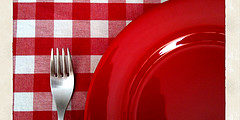 Stop and think about the color red.
Stop and think about the color red.
… Get it? Stop and think. The color red conveys different meanings throughout the world. In North America, the color red is used for stop lights and stop signs. It also serves this purpose in other nations in addition to representing personal emotions.
According to incredibleart.org red also represents “Excitement, energy, passion, love, desire, speed, strength, power, heat, aggression, danger, fire, blood, war, violence, and all things intense and passionate.” In Eastern cultures, red indicates happiness.
Red comes in all shapes and sizes, but these meanings are rather consistent. Lately, however, red is a color of contradiction.
Red, a Color of Contradiction
The journal Appetite recently issued a new study that arrived at a simple conclusion: “the color red reduces consumption.” But don’t be quick to add “appetite suppressant” to its list of traits. For years, branding experts have been saying that red stimulates hunger. Karen Haller is a color and branding expert who confirms this by saying, “red triggers stimulation, appetite, hunger, and it attracts attention.”
It is no secret that people are drawn to the color red, after all, red lipstick, cocktail dresses, and roses are thought to be very alluring. How can it encourage one’s appetite while decreasing consumption?
Cognitive psychology researcher and author of the new study Nicola Bruno seeks to answer this question. She evaluates the consumption of 240 volunteers given popcorn, chocolate, or hand cream on different colored plates.
The CNN article covering this topic states, “On average, people ate less popcorn and chocolate when they were served on red plates compared to blue or white plates.” But this is not exclusive to food. “Moisturizing cream followed a similar trend. When testing hand cream on red plates, people used about half as much, on average, compared to cream on blue or white plates.”
Oliver Genschow, who studies consumer psychology at the University of Mannheim, agrees that “the study supports the idea that red reduces consumption.” However, the research only goes so far as to say this is a “subconscious” phenomenon. Should people know red decreases consumption, eating from red plates may not help them. Considering branding experts are convinced red triggers hunger, it is probably best to stop… and think about what’s on the plate.
Image made available by luizfilipe on Flickr through Creative Common Licenses.
Read more Segmation blog posts about Color Psychology:
Red and Green are an Unlikely Pair
Be a Artist in 2 minutes with Segmation SegPlay® PC (see more details here)
Join us on FacebookSegPlay® Mobile iTunes now available for iPhone and iPad







Dear Mark, I am happy to hide a small present for you under Christmas tree, please unwrap it:
http://glorialana.wordpress.com/2013/12/23/12-friends/